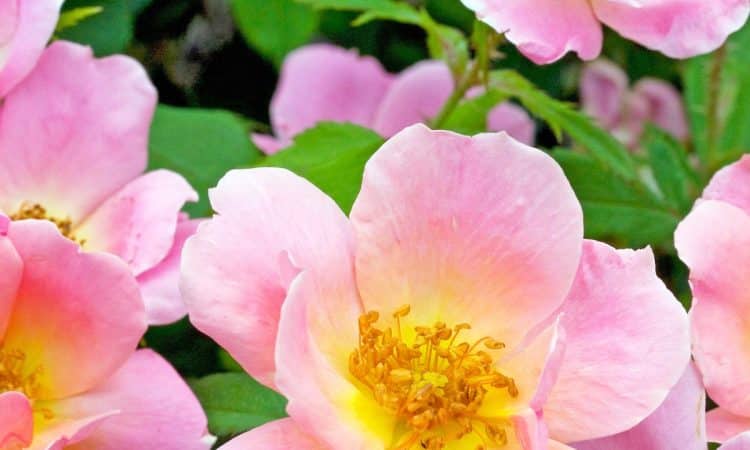
Perennial plants are garden stalwarts but are not often considered the most prolific bloomers. This accolade is usually reserved for pretty annuals, which have a starring role over one growing season before dying off once the frost hits.
There are many gorgeous annual flowers that bloom all summer long, often continuing into the fall. However, the longest-blooming perennials rival their abundant beauty, and prove an excellent investment, returning year after year.
Whether designing different types of flower beds or choosing flowering perennials for pots, these trusty, hardy plants will add maximum impact throughout the growing season, with minimal fuss.
1. Salvia
With flower spires in shades of blue, purple, pink, or white, salvia makes a stunning addition to beds and borders, with some types blooming from late spring to fall. They are magnets for pollinators.
There are hundreds of salvia varieties to choose from, but the longest-bloomers include ‘Amistad’, ‘Autumn Sage’, ‘Black and Blue’, ‘Hot Lips’, ‘May Night’, and ‘Victoria Blue’.
Most varieties are low-maintenance, with the drought-tolerant plants requiring minimal watering and fertilization.
Plant salvias in slightly acidic, free-draining soil, where they will receive at least six hours of sunlight each day.
2. Hardy Geranium
Not to be confused with annual geraniums, which are actually Pelargoniums, hardy geranium – or cranesbill – is an easy-care perennial that comes in shades of pink, blue, purple, and white. It’s attractive to pollinators but is deer-resistant.
Plants bloom from late spring into the fall. The longest-flowering varieties include ‘Ann Folkard’, ‘Elke’, ‘Mavis Simpson’, ‘Orion’, ‘Patricia’, and ‘Rozanne’.
Hardy geraniums need regular watering after planting but are drought-tolerant once established. Plant in fertile soil and occasionally remove spent blooms for best performance.
3. Coreopsis
Coreopsis – or tickseed – produces delightful daisy-like flowers that appear between late spring and early summer, and go on into the fall. Blooms come in joyful shades of bright yellow, pink, or red.
A North American native, coreopsis is drought tolerant, attractive to pollinators, and thrives in a variety of soil types, as long as it is well-draining. Plant in full sun.
Maintenance is minimal, with only occasional watering and no fertilizing.
4. Catmint
Catmint – or nepeta – is an aromatic herb that makes a fabulous addition to the garden, with lavender-blue flowers appearing from late spring to early fall.
Less attractive to our feline friends than its cousin catnip, catmint is a magnet for bees and butterflies. It’s easy to grow and ideal for edging borders or as a companion plant on the vegetable plot to deter pests.
Plants are drought-tolerant once established but require deadheading to promote constant blooms. Grow in sun or partial shade with average, well-draining soil.
5. Coral Bells
Though primarily grown for their stunning foliage, coral bells – or heuchera – also produce gorgeous tall spikes of colorful flowers, which appear from late spring to summer, with some varieties blooming until the first frost.
The longest-flowering varieties include ‘Berry Timeless’, ‘Coral Forest’, ‘Firefly’, ‘Paris’, ‘Peppermint Spice’, ‘Red Lighting’, ‘Ruby Bells’, and ‘Southern Comfort’.
Plants thrive in partial to full shade in well-draining soil. Remove spent flowers to encourage constant blooming, and prune in spring.
6. Dianthus
Widely known as pinks, dianthus are beautiful flowers found in shades of pink, salmon, red, and white, and have a spicy fragrance similar to cinnamon and cloves.
They make a wonderful addition to flower borders or containers, and larger varieties, such as the carnation, make long-lasting cut flowers. Many varieties bloom from May to October, but deadheading spent flowers will prolong the flowering period.
Dianthus thrive in rich, neutral soil on the alkaline side, in full sun or partial shade. Fertilize in spring and water regularly.
7. Blanket Flowers
Blanket flowers – or gaillardia – are available in annual or short-lived perennial varieties, featuring daisy-like flowers loved by butterflies, in shades of red, yellow, and orange.
Some perennial types have a gloriously long bloom time of early summer to fall – such as ‘Arizona Sun’, ‘Burgundy’, ‘Fanfare’, ‘Goblin’, and ‘Sunset Poppy’ – while ‘Mesa Yellow’ flowers from late spring to fall.
Blanket flowers are easy to grow from seed and thrive in well-draining soil in a full-sun location. The plants are drought-tolerant, only requiring occasional watering once established.
8. Knock Out Roses
While roses are traditionally thought of as a summer staple, Knock Out roses have been bred to have an exceptionally long bloom time – repeat-blooming from spring to frost, with no need to deadhead.
The roses prefer a balanced “neutral” soil, and can be grown in beds or large containers. Position them to receive 6-8 hours of full sun every day.
Care involves an annual prune in late winter to early spring, and fertilizing after the first wave of flowering.

